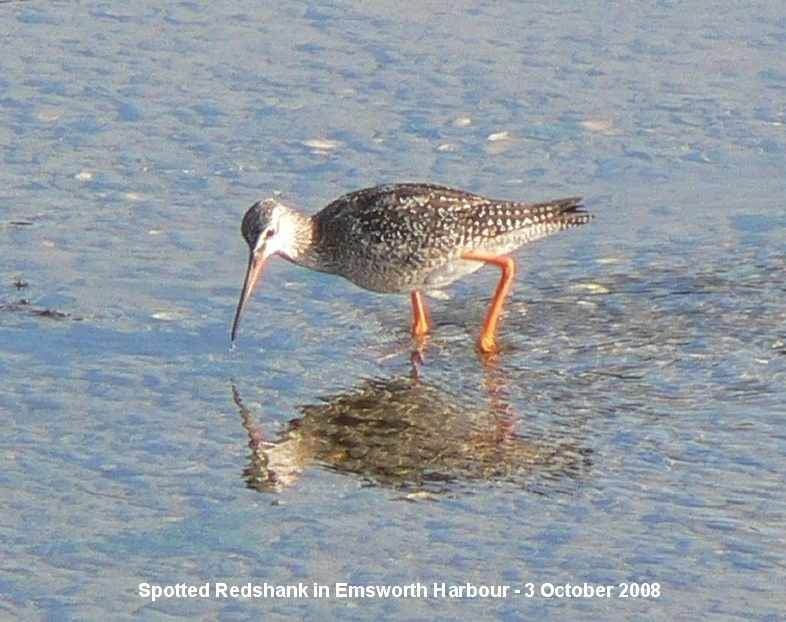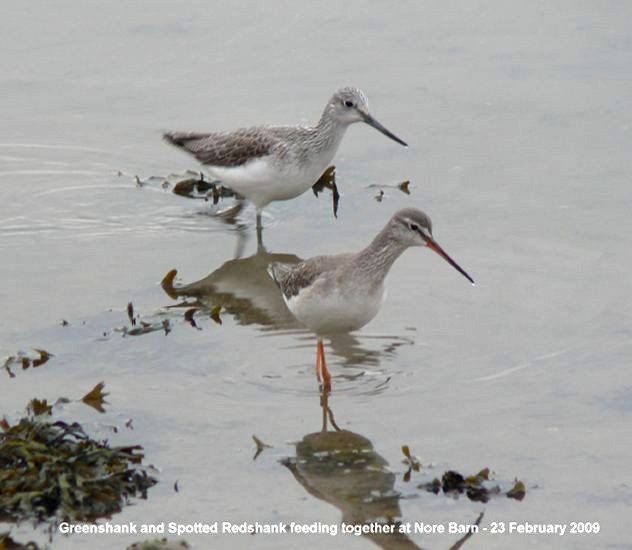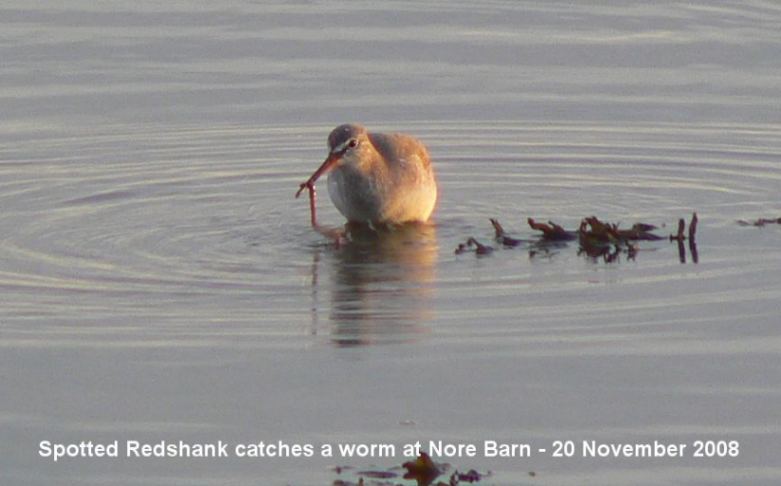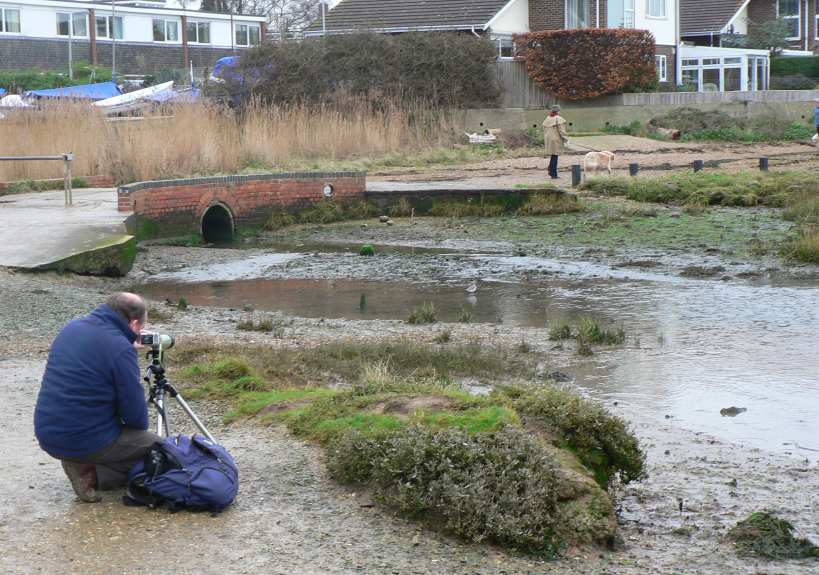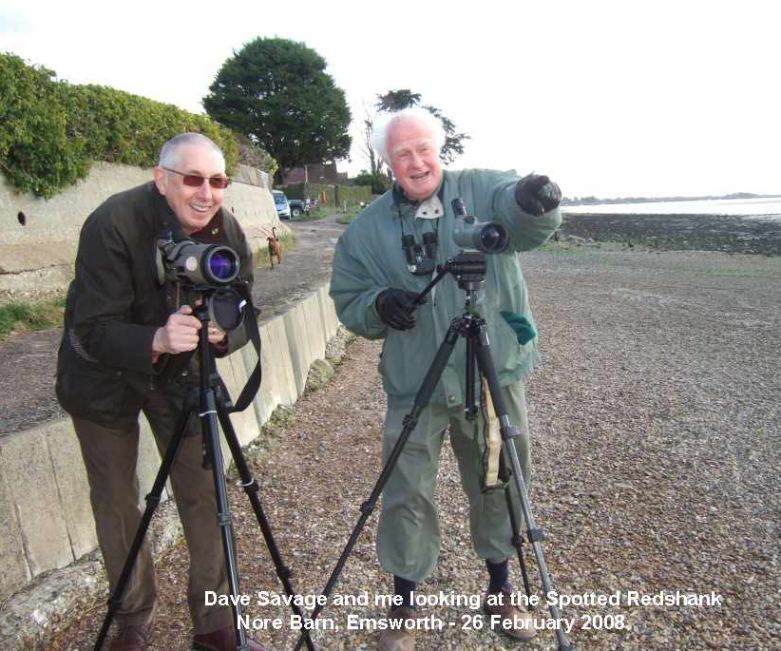SPOTTED
REDSHANK OF EMSWORTH - HOME PAGE
What I am fairly sure
is the same Spotted Redshank has turned up at the Nore
Barn stream to the west of Emsworth without fail every
winter since 2004. It is not ringed, but its timing
and behaviour strongly suggest a single bird. It
arrives usually early October and remains throughout
the winter period leaving in mid-March.
It is an amazingly 'tame' bird, feeding very close to
where people and dogs regularly walk. It is easy to
see without binoculars and is a dream bird for
photographers. It must be the most well-known and
watched Spotted Redshank in the whole country.
It usually feeds in company with other birds, such as
Greenshank, Little Egret, and Black-tailed Godwit. On
occasions, a second, and sometimes a third, Spotted
Redshank are present, but these are not
regular
Spotted
Redshank - 2021-22
. . . Spotted
Redshank - 2020-21
Spotted
Redshank - 2019-20
. . . Spotted
Redshank - 2018-19
Spotted
Redshank - 2017-18
. . . Spotted
Redshank - 2016-17
Spotted
Redshank - 2015-16
. . . Spotted
Redshank - 2014-15
Spotted
Redshank - 2013-14
. . . Spotted
Redshank - 2012-13
Spotted
Redshank - Photo archive - before 2012
First
and last dates for the regular Spotted Redshank at
Nore Barn
1st Year: 2004-05:
first sighting on 26-Dec-04 . . . Last sighting
11-Mar-05.
2nd Year: 2005-06:
first sighting on 15-Dec-05 . . . Last sighting
20-Mar-06
3rd Year: 2006-07:
first sighting on 09-Nov-06 . . . Last sighting
22-Mar-07
4th Year: 2007-08:
first sighting on 05-Nov-07 . . . Last sighting
17-Mar-08
5th Year: 2008-09:
first sighting on 08-Nov-08 . . . Last sighting
18-Mar-09
6th Year: 2009-10:
first sighting on 21-Oct-09 . . . Last sighting
24-Mar-10
7th Year: 2010-11:
first sighting on 19-Oct-10 . . . Last sighting
19-Mar-11
8th Year: 2011-12:
first sighting on 21-Oct-11 . . . Last sighting
9-Mar-12
9th Year: 2012-13:
first sighting on 09-Oct-12 . . . Last sighting
27-Mar-13
10th Year: 2013-14:
first sighting on 11-Oct-13 . . . Last sighting
13-Mar-14
11th Year: 2014-15:
first sighting on 03-Oct-14 . . . Last sighting
20-Mar-15
12th Year: 2015-16:
first sighting on 27-Sep-15 . . . Last sighting
21-Mar-16
13th Year: 2016-17:
first sighting on 11-Oct-16 . . . Last sighting
16-Mar-17
14th Year: 2017-18:
first sighting on 22-Oct-17 . . . Last sighting
22-Mar-18
15th Year: 2018-19:
first sighting on 29-Oct-18 . . . Last sighting
23-Mar-19
16th Year: 2019-20:
first sighting on 31-Oct-19 . . . Last sighting
04-Apr-20
17th Year: 2020-21:
first sighting on 08-Oct-20 . . . Last sighting
23-Mar-21
18th Year: 2021-22: ??
For latest news see year entry at . . .
Spotted
Redshank - 2021-22
Is
it the same bird?
This is a question people often ask me . . .
'Is it the same bird that has been coming for the
past 15 years?'
My answer is that I have no definite proof as it is
not ringed or tagged. But having monitored and watched
the bird very closely and taken lots of photos and
videos of it over the past 15 years I am sure it is
the same bird for the following main reasons.
1. The arrival and
leaving dates of the Spotted Redshank are always
roughly the same - arriving mid to late October and
departing mid to late March.
The relatively late
arrival date suggests our bird is a male as the
females tend to come through on passage much earlier
Aug-Sep. In Spotted Redshanks the female leaves the
nest soon after laying and leaves the male to brood,
hatch and fledge the young before leaving himself.
Hence, his lateness in arriving on wintering
territory.
2. Its timing in
the stream has been constant. It returns to the
same small tidal area which is fed by a fresh water
stream from inland. It arrives at the stream 2-3 hours
before and after high water, depending on the height
of the tide, and remains there feeding for at least an
hour each visit. It sometimes roosts on the
saltmarshes.
3. Its general
tameness in the stream is a distinguishing feature
of the Spotted Redshank. It is often referred to as
'the tame Spotted Redshank' It is so confiding
allowing close approaches with no obvious fear, though
it is always alert to anyone of thing getting too
close. It is a cinch to photograph and video. It has
been called 'A photographer's dream bird'. I have
hundreds of good images on my computer and I only use
a simple point and shoot camera. People come from far
and wide to take its photo.Surely, it must be the most
photographed Spotted Redshank in the world! It annoys
me to see photographers creeping to within metres of
the bird, often with huge lensed cameras which are
totally unnecessary. But the bird takes no notice.
4. Its feeding
behaviour in the stream in much the same way each
time. I can now spot it easily a good 50 yards away at
the end of Warblington Road. It often feeds with a
regular feeding companion - a colour-ringed Greenshank
(G+GL). Occasionally a second, or even a third,
Spotted Redshank turns up to feed with the regular
bird which it tolerates and they are often quite
friendly together. Generally, the Spotted Redshank
does not tolerate the presence of a Common Redshank,
though it is indifferent to other regular feeders in
the stream, including Mute Swans, Black-headed Gulls,
Black-tailed Godwits and Little Egrets.
3. Its tolerance to
disturbance. This is a very heavily used area for
dog walking and visitors birdwatchers are often
disturbed when they see dogs dashing into the stream
to chase the birds. However, I have learned not to
worry too much as the bird always flies off to the
saltmarshes if the dog gets too close, returning once
the unruly animal has gone. Whenever I get the chance,
and have the courage, I speak to the dog owners hoping
to impress on them the importance of not disturbing a
rare bird that has flown such a long way to spend the
winter with us. I have done my bit towards educationg
the local people to see how lucky they are to have
such a wonderful visiting their area. My policy is
always education before legislation. Local people have
certainly adopted the bird and adopt a policing policy
of their own which is good.
Colour-ringed
Spotted Redshanks
There are also two
colour-ringed Spotted Redshanks in the local area,
which are also occasionally seen at Nore Barn. They
are coloured W+GY and W+GR.
For more details on these go to . . . Spotted
Redshanks - colour-ringed
HOW
TO GET TO NORE BARN
Going east
along the A27 towards Chichester, take the A259 into
Emsworth. Then take the third turn to the right down
Beach Road and at the end turn right into Warblington
Road. You can easily park near the end of the road
overlooking the harbour. Walk another 50 yards to get
to the bridge over the small stream at Grid Ref:
SU740053. This photo shows a view of the Nore Barn
area looking west. The stream where the Spotted
Redshank feeds is just before the woodland in the
distance.
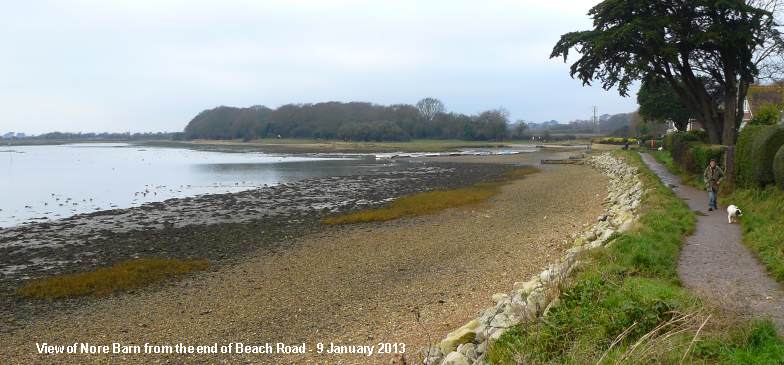
Discovery
of the Emsworth
Spotshank
Ralph Hollins
was the first to report a Spotted Redshank at Nore
Barn on 26 December 2004. He had two more
sightings of the bird for the winter 2004-5. Martin
Hampton saw it on Feb 6 (and was surprised by the
close view he had!), then Ralph himself saw it again
on 11 Mar 2005, which was the final sighting for that
winter. Ralph had no earlier sightings before
26-Dec-04, so it seems as if that was the winter it
first discovered the joys of the Nore Barn stream.
I first saw the bird the following winter (2005-06) on
15 December 2005 and I remember the occasion
well, as I had never seen a Spotted Redshank that
close before. I certainly did not realise at the time
what an attraction this bird was to become over the
next few years, nor that it would put Emsworth firmly
on the local (and even, at times, on the national)
birding map.
Note
on longevity
From the BTO
web site the maximum recorded age for Spotted Redshank
is 7 years 5 months 16 days (set in 1983). The present
bird clearly beats this record. However, I suspect the
BTO record simply reflects lack of data, as the the
longevity record for the more closely studied
Greenshank is over 16 years and that of Redshank over
20 years.
Note
on nesting and
migration
Nesting
grounds of the Spotted Redshank are almost entirely
within the Arctic Circle from Norway eastwards through
Finland to the forest zone of Siberia. Most migrate
southward to winter in the Mediterranean region and in
Africa south to the Equator and even to South Africa.
A few over-winter locally in the South of England.
Spotted Redshank share their forest-marsh nesting
grounds with Wood Sandpipers, Greenshank, Whimbrel,
Jack Snipe and Broad-billed Sandpipers. They are noisy
birds on their breeding grounds and their distinctive
'tchuet' flight calls are constantly heard.
Spotted
Redshank plumage
We only see
the Spotted Redshank in its winter plumage in
Emsworth. As shown in the following photo this is
bright and clean looking, grey above and white below
with orange to reg legs. The bill and legs are much
longer than in the Common Redshank.
The
Emsworth Spotted Redshank in winter plumage
(Photo by Trevor Carpenter 7 November 2007)

The summer breeding
plumage of the Spotted Redshank is totally
different from the winter plumage. It is jet black and
liberally spotted with white - from where it gets its
name. Its legs in summer are almost black as well. I
took the following photo in mallorca in April 2005.
The bird was on passage back to its breeding grounds
and was already in its breeding plumage.
Spotted
Redshank in breeding plumage
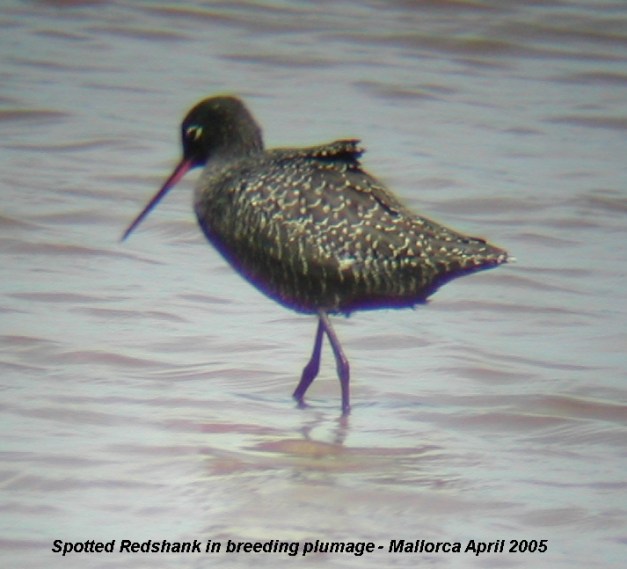
We had a one-off
sighting of a juvenile Spotted Redshank
beginning its moult into first-winter plumage in
Emsworth Harbour in October 2008. Here is a photo of
that bird.



